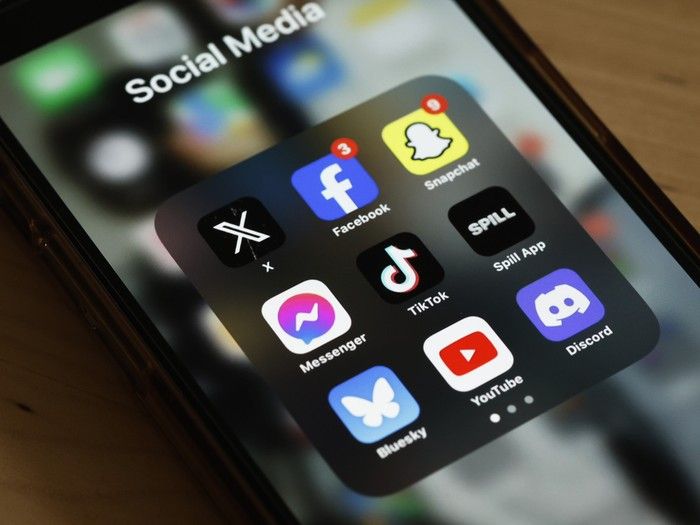
During a visit to a friend’s place, Zack Plourd found his friend’s medication for Adderall, one of the most common medications for ADHD or attention-deficit hyperactivity disorder.
While Plourd had never sought a prescription for his self-diagnosed ADHD, he decided to try the Adderall. To his surprise, it helped with symptoms he’d struggled with, such as lack of focus, rambling when talking, and the constant need to keep his brain stimulated. So he asked his doctor for a prescription.
As a result, he said, “I can think. I can exist. I can do things now.”
Plourd has self-diagnosed for years, based on content he’s seen online and his real-life conversations.
One of the first signs he identified with was people with ADHD talking about taking stimulants, such as caffeine, to focus. TikTok has thousands of videos that describe the habits of people with ADHD. Advice and clips on how to manage these habits and overcome the hardships of living with ADHD can be seen on several social media platforms.
Whenever Plourd sees these videos, he relates: “I have those things. I do those things.”
Plourd is typical of a growing number of people who diagnose themselves with a mental illness based on information on social media. Most of this content is found on TikTok, where youth and young adults are the most active users. It’s a trend that deeply concerns professionals, who fear misdiagnoses — or worse.
Sun-Ha Hong, an external faculty fellow at the Stanford Humanities Center with expertise in social media platform governance and AI, said social media platforms continuously feed the user content that is based on their interests. Their algorithms push content that keeps the user scrolling and keeps them on the platform longer.
“Because that’s really what makes it profitable for them,” Hong said. “So that may not always be the healthiest content for you.”
Social media platforms’ algorithms also redirect harmful content, such as content that promotes eating disorders, self-harm or even suicide.
According to the Center for Countering Digital Hate, an international non-profit and non-governmental organization, TikTok recommends self-harm or suicide content within 2.6 minutes and eating disorder content within eight minutes to new teen users who express interest in mental health content.
This recommended content, rather than helping users, can cause mental health issues, such as developing eating disorders, internalizing harmful body images or engaging in self-harm.
Millions of posts, billions of views
Content related to ADHD has gained traction on social media, particularly on TikTok.
TikTok content creators such as Ontario’s Olivia Lutfallah and Kansas’s Connor DeWolfe have gained a large following from posting ADHD-related videos. Some of their videos have averaged more than 100,000 views. A few have had millions of views.
Social media has become a tool to get information on all kinds of mental health conditions or neurodivergent tendencies, and the needs related to them.
According to TikTok , which was launched in 2016, topics related to mental health, self-care and mental-health awareness have had more than 100 billion views as of October 2023.
On Instagram, a search of the topic “mental health” shows more than 57 million posts since 2010 while “mental health support” has more than three million.
According to the 2023 B.C. Adolescent Health Survey of youth in Grades 7 to 12, more than 8,000 adolescents out of 38,000 said they get their mental health information online. Online sources ranked third after consulting family or friends.
In a 2024 study by the peer-reviewed Journal of Medical Internet Research , 21 youth respondents in B.C. noted that TikTok is seen as an “easy way to access mental health information” with the added benefit of being free, relatable and engaging. The study found that youth engagement with the topic of mental health surged on TikTok during the pandemic, as it softened the effects of social isolation and provided access to mental health information and support.
However, the study warned that “TikTok can adversely impact mental health through repetitive exposure to mentally distressing content and misleading diagnosis and treatment information. Regulations against harmful content are needed to mitigate these risks and make TikTok safer for youth.”

Barriers to professional help for mental health
Self-diagnosis is often the default for people who face high costs for private assessments and long waits for doctors who can diagnose them.
A small-sample survey by the non-profit organization AutismBC showed 34 per cent of its member respondents self-diagnosed or self-identified as autistic, according to Suzanne Perreault, executive director of the non-profit organization, which has a membership of more than 10,000.
Social media content can help people to understand more about themselves and to recognize “the ‘why’ behind ‘why I do what I do,’” said Perreault, who self-diagnoses as being on the autism spectrum.
According to the B.C. Autism Assessment Network, the waiting time for a child to get an assessment is 80.6 weeks . After the assessment, it can take four to six weeks to receive the results.
Perreault said adults have more limited options, and the wait for an assessment is around two years.
If one wants to get an assessment faster, the only option is to get it privately, which can cost up to $4,000.
A 2023 study by Statistics Canada found almost half of the people who meet the diagnostic criteria for mood, anxiety and substance-use disorders have not spoken to a health professional about their mental health during the past year. And even fewer talked to a specialist such as a psychiatrist or a psychologist.
That’s at least in part because public facilities dedicated to mental health are hard to find and to access, said Dr. Edward Taylor, a UBC Okanagan researcher and mental health clinician who has worked with children and adolescents.
Taylor believes people turn to social media out of convenience and the comfort of anonymity, partly because the support system in B.C. is overburdened, which has created the “lack of availability of a professional support system.”
Both funding and the availability of training for mental health professionals are missing, he said: “They go hand in hand here in British Columbia.”
According to a 2023 study by Family Medicine and Community Health, B.C. is one of the provinces with the greatest shortage of family physicians, with 17.7 per cent of the population reporting they have no family doctor. That means approximately 940,000 British Columbians have no family physician.
The lack of an adequate professional support system shows in the long waiting times in B.C.
“If it’s difficult to find, difficult to get into, if there’s a waiting list, you tend to just … move away from it,” Taylor said.
With so many barriers to getting professional help, it’s not surprising that so many people turn to self-diagnosis. But the trend of self-diagnosis is troubling, said Taylor.
He warns there is a possibility of misdiagnosis, in some cases due to an overlap of symptoms. For example, depression and anxiety can cause someone to have symptoms resembling obsessive-compulsive disorder. These symptoms can also have the “appearance of regular depression” but can be indicators of bipolar depression.
Self-diagnosis can lead individuals to develop preconceived ideas of what they have and what medicine they need to get it treated, so that the doctor-patient relationship and trust is weakened, said Taylor.
“They go to a physician, but they come in with a predetermined idea that a certain medication is what they need before they have a professional diagnosis,” he said.
For someone who doesn’t know the distinction between different conditions, as a doctor would, the wrong treatment can lead to dangerous consequences. Medications that can treat a particular type of illness can hurt a misdiagnosed individual.
A self-diagnosed patient may be well-informed and, in some instances, even be able to persuade a time-pressed physician to agree to treatments that prove to be inappropriate, Taylor said.
An example is SSRIs or selective serotonin reuptake inhibitors, a common class of medication given to people with depression. There can be chemical differences between different kinds of SSRIs. For people who have bipolar depression, which can exhibit symptoms of “regular depression,” the wrong medication may throw them into a manic attack.
A step on the road to professional diagnosis
It’s been more than a year since several states in the United States filed lawsuits against TikTok and Meta, alleging the platforms are intentionally or negligently designing products that harm youths’ mental health.
In Canada, four Ontario school boards launched a lawsuit against TikTok, Meta, and Snap, charging that the platforms were “negligently designed for compulsive use” that disrupts student learning.
In the court case, one of the allegations of the Toronto school board is that these social media giants employ “exploitative business practices and have negligently designed unsafe and/or addictive products” that they promote to students.
There are now 14 school boards in Canada suing the social media giants, according to the Schools for Social Media Change website.
Some platforms have said that they are making changes to their systems to safeguard users from harmful content. Meta has said it introduced automatic restrictions so searches related to harmful content are not shown, and that the user is redirected to experts for help.
However, how platforms deem content to be harmful is mostly unknown to governments and independent researchers because social media platforms do not explain their algorithms.
According to Stanford’s Hong, most of what researchers know is based on results gathered from reverse engineering algorithms.
“We have to trust these companies when they are telling us, ‘This is how it works,’” he said.
In an in-app survey conducted by TikTok in September 2023, 63 per cent of 1,898 respondents in Canada said they find a sense of belonging on the platform.
The recent Journal of Medical Internet Research study, while cautioning about misdiagnosis and the adverse effects of self-diagnosis on mental health, conceded that “findings suggest that TikTok can be a useful tool to increase mental health awareness, reduce stigma, and encourage youth to learn and address their mental health challenges while providing a source of peer connection and support.”
“It creates empowerment,” said Perreault. “Create inclusive spaces, create spaces for listening and acceptance.”
Perreault sees videos on social media as a “gentle introduction” on the road from self-identification or self-diagnosis to a final diagnosis by a medical professional.
As for Plourd, he applied to the government for disability benefits. He said approval would allow him to focus on improving his mental health or working toward his aspirations.
“Once the stress of ‘can I pay rent this month or eat’ [goes] away, that relieves a lot of anxiety,” he said. “That means I can focus on getting healthy.”
While he believes there is a different degree of validation that comes with getting an official diagnosis from a medical professional, he said it’s important not to play down the validity of self-diagnosis.
“Because I know me better than most people do,” Plourd said. “I live in here.”
Thea Catipon is a 2024 recipient of the Langara College Read-Mercer Journalism Fellowship. This feature was produced through the Fellowship.
Related
For more health news and content around diseases, conditions, wellness, healthy living, drugs, treatments and more, head to Healthing.ca – a member of the Postmedia Network.